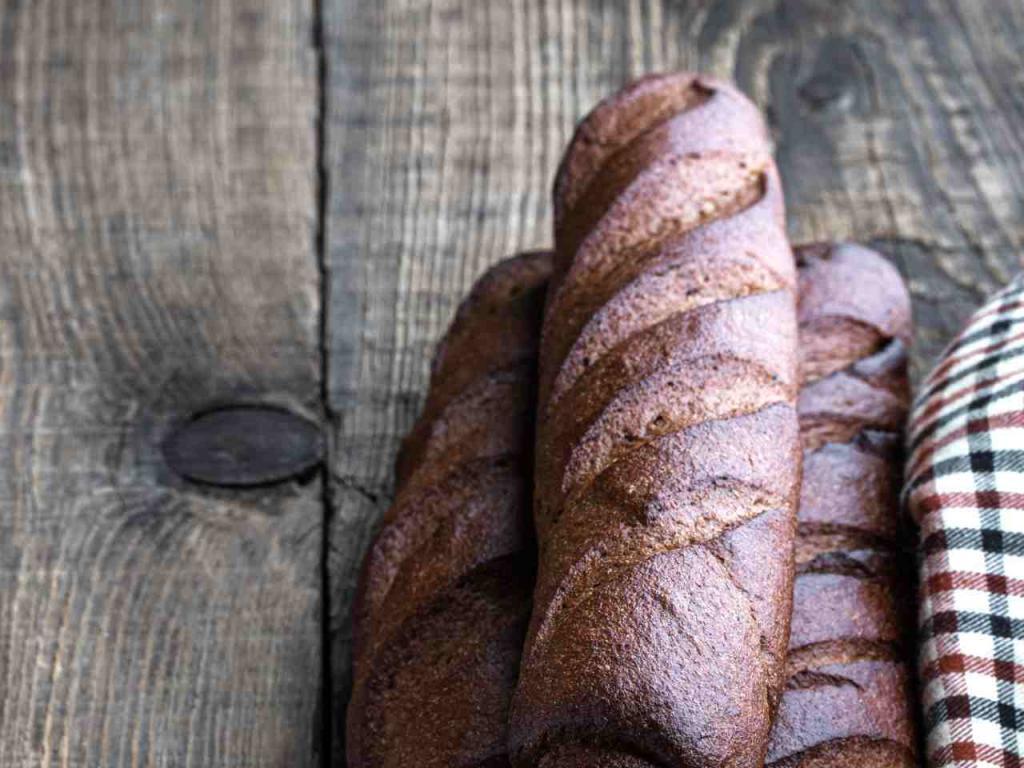
The History Of The French Baguette

The French baguette’s flavour, look, and texture are international symbols of France. The baguette’s iconic shape is the most notable in the world. Millions are eaten daily, with 10 billion baguettes in France sold each year. That’s half a baguette each day per resident! Crazy!!
For tourists, it is a formality to try a real French baguette when visiting France. But the origin of the baguette is filled with myths and mysteries, so I asked myself, “what is the history of the baguette?” and “what is it that makes baguettes so popular?” Here is what I found out.
Why is a baguette called a baguette?
Translated to English, “baguette” means a “stick” or “wand” due to its shape. It derives from the Latin word “baculum”, now replaced in the modern Italian language with “baccheto”. Outside of France, it is common to refer to baguette bread as a “french stick” or simply “French bread”.
The characteristics of a French baguette
The crumb of an authentic baguette contains large irregular holes supported by a strong springy gluten network. The colour of the crumb is chalky-yellow, not white. After pressing the crumb with a finger, it springs back to its original shape. The iconic crust is golden, thick and crispy.
How are traditional baguettes made?
Most baguettes are made with yeast, whilst a preferment such as a poolish or sourdough starter can be added. Yeast provides the leaving power, whilst a preferment boosts flavour, texture, keeping quality, and further enhances the rise. 100% sourdough baguettes are also popular.
When making a baguette ordinaire (standard baguette), the baker divides the dough into 390-gram pieces.
Traditionally, baguettes are proofed in a linen cloth called a couche. The couche is floured, and a moulded baguette is placed. The couche is folded along both lengths to act as a barrier between rising baguettes and to stop the baguettes from spreading sidewards.

Once proved, they are removed from the couche using a baguette peel and placed on a board, scored with a razor blade, and slid into the oven.
The score or “la grign” is typically 8 cuts for a full-size baguette. The perfect angle and distance between each cut matters, and takes experience to master.
There are likely to be differences between every baker’s scoring angles. To protect a bakeries signature, in some bakeries the same baker cuts the bread each day.
Once baked, each baguette weighs around 250 grams. The high weight loss is due to moisture evaporating from its large surface area. See my authentic French baguette recipe with poolish to give them a go yourself!
Baguette origin myths:
There are a few stories that surround its first origins:
Baguettes were produced for Napoleon
Napoleon Bonaparte wanted soldiers to eat between battles, so a specifically measured pocket was inserted in every fighter’s jacket and bakers were instructed to produce a long stick-like bread to go inside.
We know that a long, stick bread was produced around the time of Napolean. Although, for reasons I’m about to explain, there are major differences between these stick loaves and the baguettes of today.
Baguettes were produced to reduce stabbings in Paris
When the Paris metro system was being built, fighting struct between workmen from different suburbs. They just would not get along! At this time it was common for workers to carry a knife in their pocket to slice bread, so a construction supervisor working on the Parisian metro asked bakeries to produce a bread that didn’t require slicing.
The metro system was built at the turn of the 20th century, only 20 years before it became popular. This could have been the first conception of the baguette, although there is little evidence to prove or deny it.
When was the baguette invented? -The history of the baguette timeline
Pre 1700’s
Bread was a cheap and available source of carbohydrates, protein and minerals, and would have accounted for around 50% of peasants’ diets. Grains included wheat, rye and buckwheat, depending on the region they were in.
Not long before, peasants would grind their own flour from the whole of the grain. As milling methods improved (windmills), it became possible to separate the bran from the grain and produce white flour. The process to do this was expensive, which meant that white bread became a product only for the rich.
1700’s
It is documented that a long bread was baked in French bakeries during the 1760s. These loaves are described as 1 yard, sometimes 2 yards long! They would lie along the length of tables -so they didn’t fall on the floor! I’ve not found a name for this bread, but it is likely to be related to the Ficelle.
During the late 1700s, poor harvests and a growing population led to wheat prices soaring. The poor couldn’t afford to eat anything, let alone their daily bread. This, amongst other political issues, started the 1789 French Revolution which led to the king being removed. After this, a 1793 decree, sometimes regarded as French bread law, stated:
“Richness and poverty must both disappear from the government of equality. It will no longer make a bread of wheat for the rich and a bread of bran for the poor. All bakers will be held, under the penalty of imprisonment, to make only one type of bread, The Bread of Equality.”
1800’s
As the 19th century began, the recently passed French bread law worked to ensure bread was accessible to all. Popular bread types were; Pain au Levain (sourdough), Pain de Campagne, Brioche and Pain de Seigle (rye bread).

The emergence of baker’s yeast during this century changed the process of making bread. It was no longer necessary to make bread in small batches or spend days preparing sourdough. Bread was produced en-mass in boulangeries (bakeries) and less by the housewife.
The Hungarian roller mill was introduced to France. This method meant less damage to the grain, resulting in better flour quality.
One of the most revolutionary pieces of baking equipment was also introduced in this century. In 1839, the first steam-baking oven was unveiled by August Zang in his bakery “Boulangerie Viennoise” at 92, rue de Richelieu, Paris.

The Viennese steam oven meant bakers could create lighter loaves with incredibly crispy crusts. Steam delays the setting of the crust to promote a larger oven rise with a crispy crust with a shiny gloss.
August Zang used this oven to wow Paris with his “Vienna bread”, a long sweetened soft bread with a slender shape like a demi-baguette. He also brought the Kipfel to France, which he developed into the French Croissant. These products are classified as Viennoiserie.

There is a theory that August Zang also invented the baguette. But, there is no evidence other than the connection between the steam oven and baguettes. As far as what has been recorded, the baguette was unheard of at this time.

1900’s
After the first world war ended in 1918, France underwent a massive rebuilding project. Because of this,
Why were French bakers forced to start baking at 4am?
The government were struggling to build enough houses alongside repairing its infrastructure. The economy was in desperate need of stability and strong actions were required to avoid bankrupting the nation. It was deemed necessary to control the rate of economic growth to stop industries from over-expanding. One way of doing this was to restrict night workers so the French government invoked a ruling to stop bakers from working between 10 pm and 4 am.
The change in working hours caused a problem. Bakers could not produce traditional large loaves for an 8 am opening without destroying their quality. Nor could they leave the dough overnight to rise, fridges and automatic proofers didn’t exist! They needed a new product that was quick to make, tasty, and profitable.
Steam ovens were common in French bakeries. Despite improving traditional classics, all of the bread that utilised steam originated in Vienna. I bet French bakers would have been desperate to produce a French bread that utilised steam baking!
1920
The first written record of a baguette comes from 1920, found in a regulation of the department of the Seine. It declared that a baguette would not be sold for more than 0.35 Francs apiece. It was also determined a minimum weight of 80 grams and a maximum length of 40cm.
It’s accepted that the modern baguette was born between 1900 and 1920, which puts weight on the theory that it was invented for metro workers during this period.
The citizens of Paris quickly warmed to the new bread, and its popularity spread to the rest of France. And later, the world.
Why is the baguette so popular?
If you visit France, you’ll see baguettes eaten for breakfast, lunch and dinner. Sometimes indulged as an accompaniment, a sandwich, but just as likely by tearing off chunks and eating it on its own.
Its light aerated crumb is coupled with a crunchy, strong crust. But it isn’t just the texture that’s won its reputation. The flavour is just as important.
The flavour of a baguette can be described as delicate enough to not overpower, with enough interesting deep aromas to provide excitement. They are the perfect accompaniment to food or eaten on their own.
Going to a boulangerie is a part of daily life in France, and one located in just about every shopping strip or small village.
Baguettes turn stale quickly and are best eaten within 5 hours of production. This means residents visit a boulangerie every day to pick up a fresh loaf, with some going more than once!
Bakers find that it is very profitable to produce baguettes because they are smaller than a large boule, but can be sold at a convenient price for consumers.
The baguette was the perfect match for business, cultural climate and customer satisfaction. It makes sense from every angle.

What types of baguettes are there?
There is a misconception that an authentic French baguette can only be made of flour, water, salt and yeast. Whilst a beautiful baguette can be made with these ingredients, it’s possible to include others in line with the ‘bread decree’ of 1993.
These regulations make the use of enzymes and additives in bread more stringent in France than in other countries. French bread is legally classified based on the ingredients and techniques used to produce the dough. Customers use this classification to understand the quality of the bread they are buying:
Le baguette de tradition Française
All ingredients must be obtained from natural sources, and the dough can not be frozen. No chemicals and only six additives are allowed, which are:
- Bean flour
- Soya flour
- Gluten
- Fungal amylase
- Malted wheat flour(malt flour)
- Deactivated yeast
There are limits to how much can be used, which you can see in the French bread ingredients post.
TIP: Look for the Artisan Boulangerie label when selecting bread or a bakery in France. It signifies that the bread is baked on-site.
Le baguette courant Français
Translating as “Current baguette”, there are fourteen bread additional improvers allowed in this grade of dough. They are E300, 301, 302, 304, 322, 471, 270, 325, 326, 327, 260, 261, 262, 263. Improvers can be emulsifiers or relaxing agents to remove the need for long fermentation.
Baguette au levain
This bread is raised with a sourdough levain. A small percentage of yeast can be added to the dough, but not the starter. It can include rye or wheat flour and natural sweeteners if desired. No additional additives are allowed.
Les pains spéciaux
This means pretty much anything can go in under EU law. It will be used to make a beautifully special signature bread or a mass-produced low-cost option. This bread can be frozen or par-baked and reheated on-site.
Pains bûcheron
In general, lumberjack bread is made with rye sourdough but there are variations.
Pain aux céréales
A dough containing cracked grains and seeds such as sunflower, linseed, pumpkin, millet and poppy.
What flour is used to make French baguettes?
Wheat is grown and milled in France to make baguettes. Compared to Italian and North American wheat, French flour has less protein content, and is less elastic but stretches without tearing better. It benefits from a medium bulk fermentation duration.
French flour is graded by the weight of minerals that remain after 10 grams of flour is burnt. The more bran in the flour means a higher weight and, therefore, grade. An ash level of 0.55 (T55) is typical for standard white bread. Baguettes can be made with T55 flour, yet T65 is often preferred.
If you can’t find French T55 or T65 flour, try mixing 80% strong bread flour with 10% all-purpose flour and 10% wholemeal flour. This will give you a lower protein, hearty flour that’s reminiscent of French flour. Bakers may also add rye flour for a warming depth of flavour.
Baguette grading in France
Aside from the ingredients in the dough, there are several varieties of baguettes in France. These use different production techniques, equipment or inclusions to make them special.
Baguette ordinaire
The ordinary baguette uses traditional methods of hand shaping, proofing in a couche and baking in a stone bake oven. It requires a certain level of skill to master each technique, but as baguettes are so popular, French bakers get a lot of practice!
Baguette bien cuit is a baguette that has been baked “well-done” – popular in Parisian bakeries.
Baguette moulée
Easily identifiable by the fine lattice pattern along the lower half of the bread. The method uses baguette trays (or moulds) to prove and bake the baguettes. The baker is likely to use a moulding machine to roll the dough into shape. As they require less skill and are quicker to make, baguette moulée is the popular choice in high-volume production. Outside of France, this method is common for baguette production.
Baguette Farinée
Flour-dusted before cutting and baking. They are usually baked gently for a light-coloured crust.
Baguette en épis
Épi is made from a baguette. When the dough has been proofed, it’s cut into leaves to produce a beautiful tear ‘n share loaf.
Pain flûte
A pain flûte is long and thin in shape, about twice the length of a baguette. Also called a Parisienne in the US, however, in France, a Parisienne baguette relates to a baguette ordinaire from Paris.
Ficelle
The ficelle is a thinner variation of the baguette that’s perfect for a lighter sandwich.
Bâtard
A bâtard is a wide, stubby bread shape made from the same dough as baguettes. It’s great for a fat sandwich. Bâtard translates to “bastard” in English.
Pain Vennois
Vienna bread is a sweetened bread that’s baked in a steam oven. It is often used for sandwiches but just as likely enjoyed naked with coffee. A popular variation is with chocolate chips.
Baguette variations found oustide of France:
Baguette Italienne
The Italian baguette uses Italian flour, which produces a slightly denser crumb and a chewier, less crispy crust. See the French vs Italian bread article to learn more.
Bánh mì
A short Vietnamese bread that is sliced through the middle to be made into sandwiches. It has a thinner crust and a softer, lighter crumb. This is produced with high-protein flour and small amounts of sugar and fat.
Ending thoughts on the history of the baguette
Bread has been a major part of French culture. There are plenty of signs in history that the French baguette’s popularity has no signs of slowing down! Let me know if you have more facts to add or any questions in the comments below.
https://www.discoverwalks.com/blog/the-all-important-history-of-the-baguette/
https://en.wikipedia.org/wiki/Baguette/
https://www.foodtimeline.org/foodbreads.html
https://www.cooksinfo.com/french-bread-law-1993
Baguette history frequently asked questions
If you’ve enjoyed this article and wish to treat me to a coffee, you can by following the link below – Thanks x

Hi, I’m Gareth Busby, a baking coach, senior baker and bread-baking fanatic! My aim is to use science, techniques and 15 years of baking experience to make you a better baker.
Table of Contents
- Why is a baguette called a baguette?
- The characteristics of a French baguette
- How are traditional baguettes made?
- Baguette origin myths:
- When was the baguette invented? -The history of the baguette timeline
- Why is the baguette so popular?
- What types of baguettes are there?
- What flour is used to make French baguettes?
- Baguette grading in France
- Baguette variations found oustide of France:
- Ending thoughts on the history of the baguette
- Baguette history frequently asked questions
Related Recipes
Related Articles
Latest Articles
Baking Categories
Disclaimer
Address
53 Greystone Avenue
Worthing
West Sussex
BN13 1LR
UK







